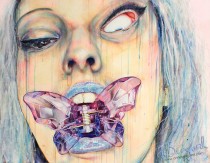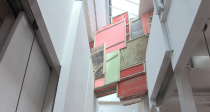Berlin is an unmade city.
Ideas and movements change direction here as rapidly as new Berliners arrive at Tegel Airport. The huge migration of creative blood in Berlin’s direction over the last 10 years has acted as the oxygen flow that allowed Berlin’s unique cultural landscape to blossom. Berlin exists in a perpetually restless, unmade state. Contrasted with London or New York, which are oft-referred to as the art world’s market place, Berlin would rather see itself as a laboratory. A place to experiment where the usual financial pressures of a capital city are looser, and the gallery system places less commercial expectations on the artist.
Berlin’s turbulent history is too long, too complicated and involved to delve in to here, but it is clear it has provided a vacuum with fewer rules and conditions than most creative centres, a vacuum that creatives have endeavoured to fill over the last two decades. I’ve been living and working here for just over a year, and during that time I’ve found myself continually redefining my expectations.
Instead of writing a vague sweeping reduction of what Berlin is today (Something someone who has spent a lot more time here than me, could do a lot better) I thought i’d talk about a few of my favourite cultural spots. Spaces, groups and exhibitions that have become highlights of my cultural experience in Berlin.

MMX is an open art venue run by a small group of artists, lead by Berlin photographer Jonathan Gröger. Existing for one year only in one of the last un-renovated buildings in Mitte’s gallery district, the non for profit group host exhibitions, film screenings, lectures, and performances on a weekly basis. MMX really reflects Berlin’s increasingly social focus on exhibiting, creating an environment where people eat, drink and interact surrounded by work of all kinds.
Their recent show “Out of Control” has attempted to draw connections between the artist-curator relationship, leading the gallery in some unexpected directions.
Each week an artists exhibits, the week after, the same artist selects and curates their replacement, for six continuous weeks. Each artist justifies their decisions and motivations for their work, and the choice of artist they selected to replace them. Leading to some bizarrely appropriate and irregular matches from week to week, eventually finding a synchronous logic by the end. My favourite being Ivonne Dippmann’s colossal wall illustrations in the court yard area seen below.

The fact MMX will exist for one year only reiterates the temporary nature of Berlin’s art scene, rarely providing opportunity for complacency.

‘Salon Poppulaire’ is a bit of a Berlin secret. An exclusive meeting point for conversation on art and neighboring topics, for the convergence of different ideas, positions and contexts. Organised by the curatorial group ‘The Office’, they Invite a host of different speakers to extrapolate on a theme, be they artist, curator or writer. They not only provide interesting speakers and topics, but the setting is one of west Berlin’s most renowned galleries. Topics such as ‘Discussions on friendship’ or “Faith and Money in art” take on a new surreal value when discussed in a space casually populated with artworks by Berlin’s Zeitgeist.
One of Berlin’s more blockbuster attractions over the summer was Olafur Eliasson’s huge show at the Martin-Gropius Bau, ‘Inner City Out’ . A grand homecoming of sorts for Eliasson in the most auspicious of locations. Although not a Berliner by birth (Like a great deal of Berliners), Eliasson has lived here for some fifteen years and not only helped define the art landscape of Berlin in that time, but has instigated and guided the redevelopment of Berlin’s more traditional Art School, UDK, in to a more challenging and relevant education institution.
The Exhibition is comprised of 28 individual works that vary in size and scope, most of which are specifically created for the Martin-Gropius Bau. Focused on a playful dialogue between the confines of the interior, the expanse of the city, landscape and architecture, the body and how the self is experienced in these contexts.
Site-specific works within the gallery are tied to a variety of associated pieces scattered throughout the city, amplifying Eliasson’s central motif, the mirror. When walking through the show (which can be experienced from two different beginning points) there is a moment where you become suddenly aware of how confounded, and inside out your senses have become. Reaching a climax in the form of a gargantuan kaleidoscope, from floor to skylight, that pulls the viewer into a dizzying architecture of infinite reflections.

Inner City Out proved to be one of the Martin-Gropius Bau’s most sucsessful shows of the last few years showing that the Berlin population has an appetite for block buster contemporary exhibitions, alongside the usually safer more traditional shows like their recent LeCorbusier or Frida Kahlo exhibitions.
Auto-Kino! a show developed by British artist Phil Collins and Siniša Mitrović featured at the Temporäre Kunsthalle this summer, presented a rotating program of artists’ videos and a varied selection of classic films. The difference being that the temporary gallery space was transformed by a graveyard of second hand cars creating a stationary indoor drive-in cinema.

The set-up playfully reevaluated the form in which video art is typically encountered, replacing its austere contemporary trappings with an almost extinct format of engagement. Featuring over 100 separate video works that take a tour through every major development in the cinematic language from the 1920’s onwards. Focusing largely on the base emotional wiring of the moving image and the notions of representation and authenticity that are intrinsic to the cinematic mode.
It was one of my favourite shows of the summer, and along with the his work in the Berlin Biennale and his recent film “”I Am My Mother” shown at Daadgalerie, Phil Collins has really transitioned well from Glasgow to his new base, Berlin.
I hope that small selection of my favorites of the last few months gives you a small idea of the scope of what is available on a weekly basis in Berlin. This city continues to be a supportive habitat for artists of every level. The vacuum shows no signs of being filled any time soon.
//////////
My Creative Scene is an insight into different creative & cultural happenings in cities where your members and readers live. Browse through more insider guides here or contact us to write about the arts scene where you are.














Comments